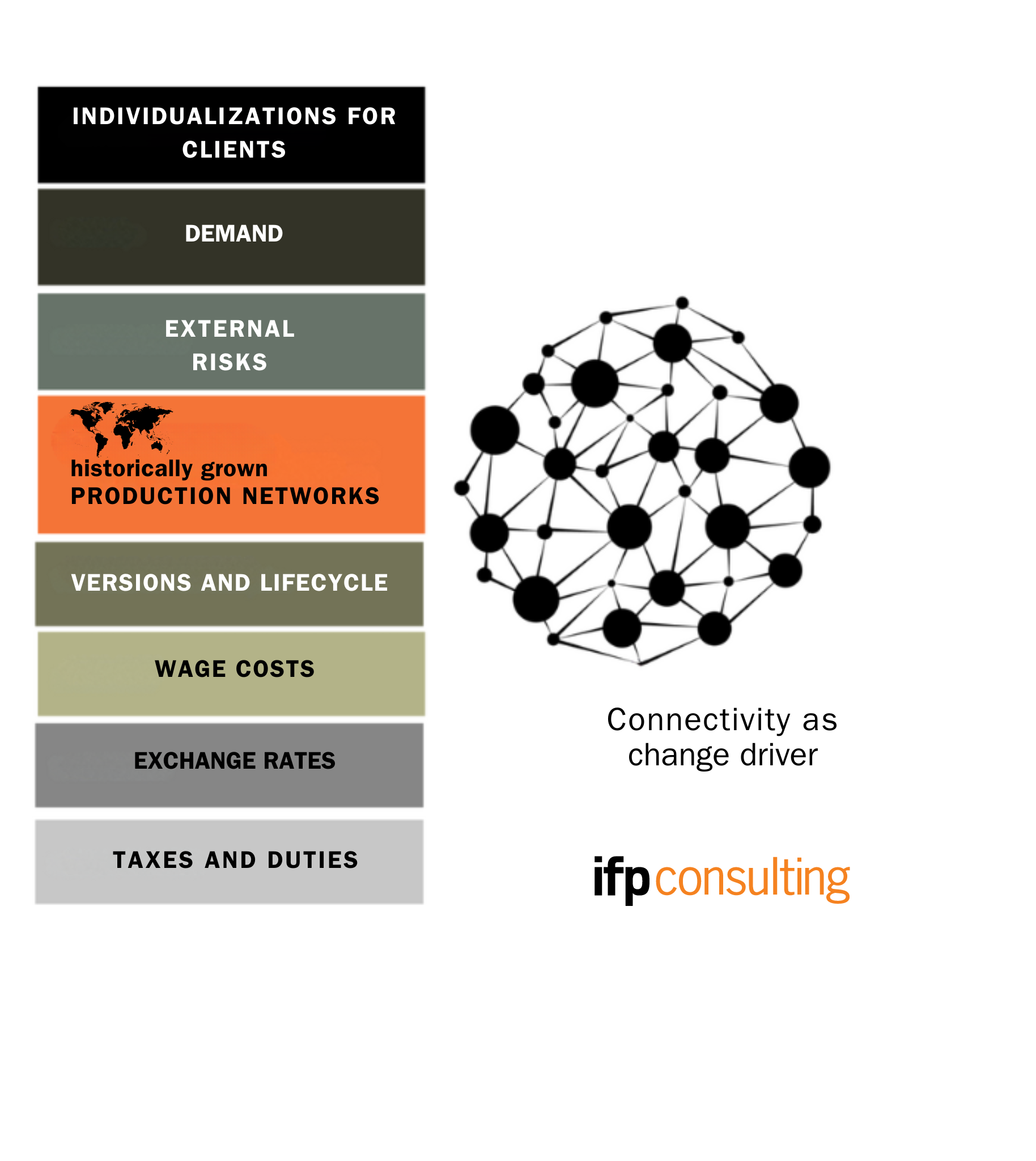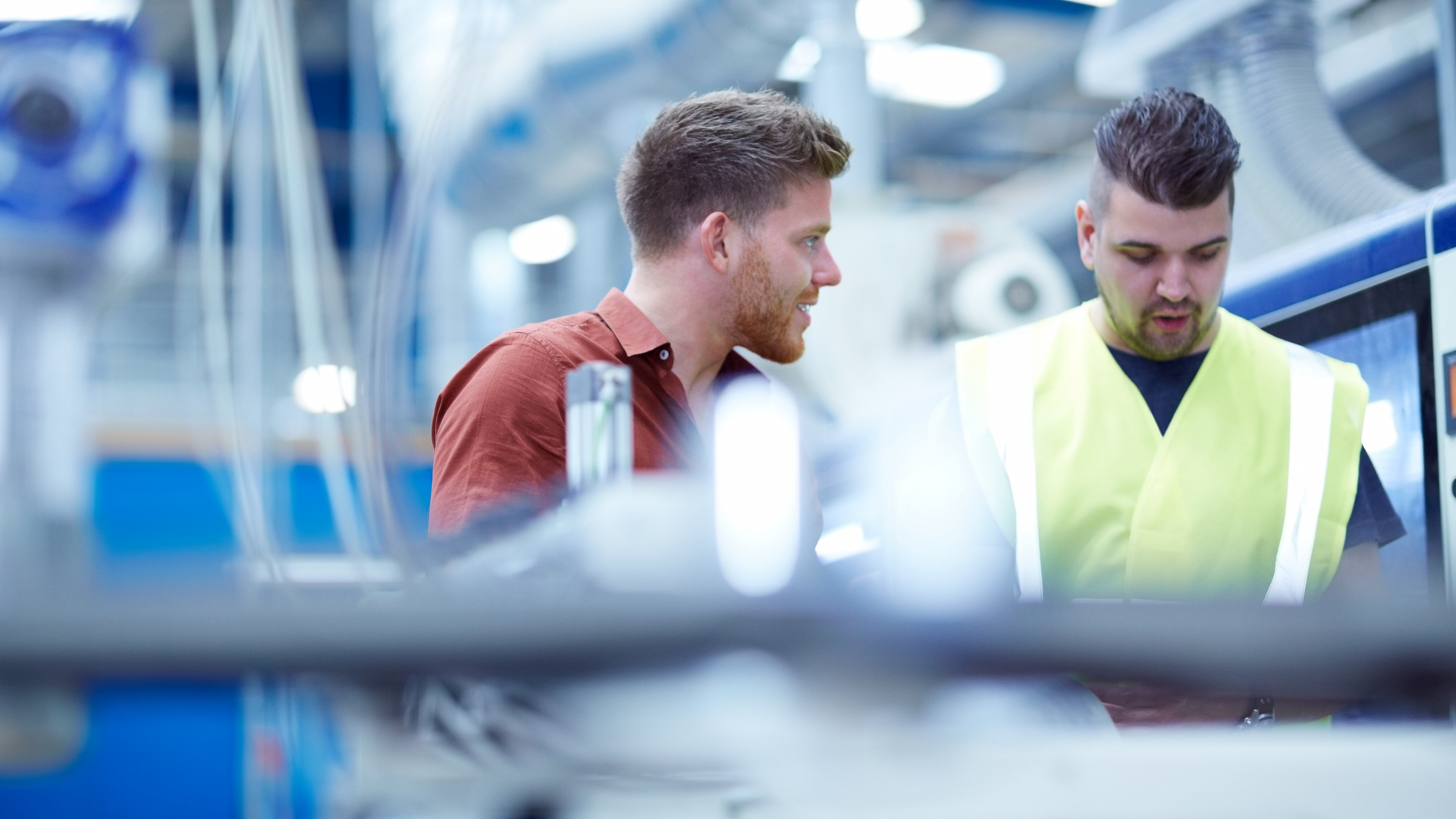Production Footprint
Efficient use of resources and capacities for your network.
Services in the area of supply chain
Services in the area of supply chain
Optimal alignment of production sites
Sustainable sales growth through use of own resources and capacities
In recent years, the optimization of complete global production networks has become the focus of attention. Above all, because the increase in performance at individual sites is reaching its limits. Due to the interconnectedness of production and supply chains, a holistic view must be taken for optimization. This also requires the questioning of roles at the various locations as well as the planned management of information and material flows.
Redesigning the footprint is a multidimensional and complex task
The Corona pandemic has further fuelled discussions on footprint issues and network configuration. There are other multi-faceted starting points, such as the question of the right location in terms of whether their suppliers can still maintain the supply chain in the pandemic situation. The increased focus on supply chain security and resilience brought on by the Corona crisis has clearly gained in importance for companies in Footprint Design.

Footprint-Analyse
A Footprint analysis requires multi-layered data collection in different areas. Thus, the required production area, the share of personnel costs, the product life cycle as well as the turnover or the sales markets are included in the consideration.
Labor costs can be set in relation to transportation costs, a transportation cost calculation with matrix can be created, or a manufacturing cost analysis can be collected. The result of the analysis is a profile of product families and restrictions at the product level for further network planning.
What are the reasons for dealing with the Footprint issue?
First, labor costs can be an impetus of thinking about a changed footprint. In Europe alone, there is a labor cost range of 5€/h to 40€/h in individual regions, which has a significant impact on fixed costs. But capacity utilization, transport costs, unnecessary redundancies, the right use of resources, access to qualified and highly skilled personnel, and an appropriate supplier structure also play a decisive role. All these influences and components of a network are constantly changing and are therefore drivers for necessary changes in the production network. The influencing factors are processed and evaluated as part of a production footprint analysis. A concrete recommendation for action for production and logistics can then be derived, as overall savings potentials.

Optimized production and logistics network
What is our understanding?
The central task in the development of a Production Footprint is the optimal alignment of the production and logistics network with the company’s goals. The following factors must be individually balanced for the company:
- Ideal vertical integration or ‘make or buy’ approach
- Technology planning and global standards in manufacturing and assembly
- Role definition of the sites
- Distribution of competence and capacity in the network
- Balanced sourcing (global and local)
- Organizational structure (centralized/decentralized)
- Know-how and innovation distribution
We support you in the development of a footprint
- Footprint design and strategy
- Development of a strategic objective and derivation of requirements
- Development of Footprint alternatives that meet strategic objectives.
- Evaluation of target variables, such as transport costs, delivery times or inventory costs through a simulation
- Planning of the steps for relocation and creation of an implementation roadmap
- For new planning or expansion planning, ifp consulting provides support with the creation of detailed factory or warehouse planning
What is the difference between network planning (Global Footprint Design) and Production Footprint?
Network planning and optimization (link to Network Optimization) refers to the entire network (end-to-end view). This means that upstream and downstream logistics processes (procurement and distribution) are also included in a global Footprint analysis. This can be distinguished from the pure Production Footprint analysis, which focuses on the orientation of the production sites. The production aspects, such as technology and competence planning, allocation of capacities and cost efficiency are considered.
Contents of a Footprint redesign
Stage / 01
Strategic objective
First, the strategic goals are defined in order to transparently present the Sense of Urgency. This enables stakeholders and shareholders to pull together. In this phase, the ifp Network Quick Check for Supply Chain Excellence is performed.
Stage / 02
Gap Analysis
The next step is to record the current situation and perform a gap analysis, which is broken down into an analysis of the value creation and the market/customer. Tools deployed: Portfolio analysis, trend analyses, sales forecasting, technological trend analyses, process cost representations, segmentation analyses.
Stage / 03
Development of Footprint Alternatives
Building on the previous stages, Footprint alternatives are developed. Depending on the strategic objective, the merging of sites is discussed, the establishment of new sites in order to reach new markets or to be able to realize growth.
Stage / 04
Simulation model
To objectively evaluate and compare Footprint alternatives, building a simulation model and testing different scenarios can be useful. Here, transport and delivery times, transport costs, inventory costs are compared. In addition, best and worst case scenarios are formed.
Stage / 05
Footprint selection
In the next stage, the results from the simulation model (measurable KPIs) are evaluated with additional qualitative evaluation criteria for each Footprint alternative. The decision is made in favor of the Footprint Alternative with the highest degree of target fulfillment.
Stage / 06
Transformation
Depending on the selected Footprint alternative, this is followed by further planning of the relocation or, in the case of new planning/expansion planning (greenfield/brownfield), detailed factory or warehouse planning.
Factors of success
However, the content points must be accompanied by other factors. This includes a team with the right competencies and skills and the use of the right methods and tools. Here, classic spreadsheet programs can no longer properly depict the often extremely complex relationships. Our special software is therefore used.
What are the biggest mistakes in restructuring the footprint?
- Insufficient understanding and lack of transparency of processes
- Misjudgements of the local situation
- Ill-considered determination of the vertical range of manufacture or make or buy
- Underestimated investments and follow-up costs
- Efficiency and quality losses in the often too long or inadequately planned ramp-up
Footprint
Take away
Realigning footprint design is a complex, strategic task. You usually only have one shot, and it should be perfectly placed because “weaving errors” in the footprint can have disastrous effects for your business.


